Studying the Process of Phosphogypsum Recycling into a Calcium Sulphide-Based Luminophor
Abstract
1. Introduction
2. Experiment
2.1. Materials
2.2. Composite Materials Synthesis
2.3. Characteristics
- -
- for monoclinic and orthorhombic phases:V = a·b·c·sinβ,
- -
- for the cubic phase:where a, b, c are unit cell parameters (nm).V = a3
2.4. Luminescent Properties Study
3. Results and Discussion
3.1. Samples’ Structures and Morphological Features
3.2. Characteristics of the Materials’ Luminescences
3.3. Selection of the Optimal Heat Treatment Duration for the Luminescent Material Synthesis
3.4. Selection of the Optimal Heat Treatment Temperature for the Luminescent Material Synthesis
3.5. Study of the Simultaneous Influence of Temperature and Calcination Time on the Luminescent Quality of the Synthesized Material
4. Conclusions
Author Contributions
Funding
Data Availability Statement
Acknowledgments
Conflicts of Interest
References
- Millán-Becerro, R.; Pérez-López, R.; Cánovas, C.R.; Francisco Macías, F.; León, R. Phosphogypsum weathering and implications for pollutant discharge into an estuary. J. Hydrol. 2023, 617, 128943. [Google Scholar] [CrossRef]
- Cao, W.; Yi, W.; Peng, J.; Yin, S. Relationship between the evolution of organic impurities and properties of β-hemihydrate phosphogypsum. Constr. Build. Mater. 2023, 409, 134125. [Google Scholar] [CrossRef]
- Bounaga, A.; Danouche, M.; Zeroual, Y.; Boulif, R.; Benhida, R.; Lyamlouli, K. Anaerobic bioremediation of acid phosphogypsum stacks leachates: Assessment of leachate’s biochemical changes and microbial community dynamics. Environ. Technol. Innov. 2024, 33, 103535. [Google Scholar] [CrossRef]
- Wu, F.; Chen, B.; Qu, G.; Liu, S.; Zhao, C.; Ren, Y.; Liu, X. Harmless treatment technology of phosphogypsum: Directional stabilization of toxic and harmful substances. J. Environ. Manag. 2022, 311, 114827. [Google Scholar] [CrossRef]
- Ennaciri, Y.; Bettach, M. The chemical behavior of the different impurities present in Phosphogypsum: A review. Phosphorus Sulfur Silicon Relat. Elem. 2023, 199, 129–148. [Google Scholar] [CrossRef]
- Wang, M.; Yuan, X.; Dong, W.; Fu, Q.; Ao, X.; Chen, Q. Gradient removal of Si and P impurities from phosphogypsum and preparation of anhydrous calcium sulfate. J. Environ. Chem. Eng. 2023, 11, 110312. [Google Scholar] [CrossRef]
- Duart, V.M.; Garbuio, F.J.; Caires, E.F. Does direct-seeded rice performance improve upon lime and phosphogypsum use? Soil Tillage Res. 2021, 212, 105055. [Google Scholar] [CrossRef]
- Wu, F.; Ren, Y.; Qu, G.; Liu, S.; Chen, B.; Liu, X.; Zhao, C.; Li, J. Utilization path of bulk industrial solid waste: A review on the multi-directional resource utilization path of phosphogypsum. J. Environ. Manag. 2022, 313, 114957. [Google Scholar] [CrossRef] [PubMed]
- Murali, G.; Azab, M. Recent research in utilization of phosphogypsum as building materials: Review. J. Mater. Res. Technol. 2023, 25, 960–987. [Google Scholar] [CrossRef]
- Shi, Y.; Song, Y.; Min, C.; Du, J.; Wang, X.; Min, J.; Wang, S. Phosphogypsum pretreatment with CaCO3 to improve the backfill performance. Case Stud. Constr. Mater. 2023, 18, e01954. [Google Scholar] [CrossRef]
- Chernysh, Y. 10-Recycling of radioactive phosphogypsum wastes. In Woodhead Publishing Series in Civil and Structural Engineering. Advances in the Toxicity of Construction and Building Materials; Pacheco-Torgal, F., Falkinham, J.O., Gałaj, J.A., Eds.; Woodhead Publishing: Sawston, UK, 2022; pp. 225–240. [Google Scholar] [CrossRef]
- Meskini, S.; Samdi, A.; Ejjaouani, H.; Remmal, T. Valorization of phosphogypsum as a road material: Stabilizing effect of fly ash and lime additives on strength and durability. J. Clean. Prod. 2021, 323, 129161. [Google Scholar] [CrossRef]
- Men, J.; Li, Y.; Cheng, P.; Zhang, Z. Recycling phosphogypsum in road construction materials and associated environmental considerations: A review. Heliyon 2022, 8, e11518. [Google Scholar] [CrossRef] [PubMed]
- Ma, J.; Xu, J.; Liu, C.; Yi, Q.; Zheng, M.; Cheng, L.; Song, T. Chemical looping combustion of sulfur paste to SO2 by phosphogypsum oxygen carrier for sulfur acid production. Fuel 2022, 323, 124386. [Google Scholar] [CrossRef]
- Pan, Q.; Ma, L.; Du, W.; Yang, J.; Ao, R.; Yin, X.; Qing, S. Hydrogen-enriched syngas production by lignite chemical looping gasification with composite oxygen carriers of phosphogypsum and steel slag. Energy 2022, 241, 122927. [Google Scholar] [CrossRef]
- Yang, J.; Ren, Y.; Lu, J.; Liu, H.; Zhang, Z.; Pang, H.; Bounkhong, K. Chemical looping gasification with a CuFe2O4-enhanced phosphogypsum oxygen carrier during reduction in a fluidized bed reactor. Chem. Eng. J. 2021, 426, 131346. [Google Scholar] [CrossRef]
- Yang, J.; Ren, Y.; Chen, S.; Lu, J. Study on the mechanism and reaction characteristics of metal-supported phosphogypsum as oxygen carrier in a chemical looping gasification application. J. Environ. Sci. 2024, 138, 428–438. [Google Scholar] [CrossRef]
- Hong, C.; Tang, Q.; Liu, S.; Kim, H.; Liu, D. A two-step bioleaching process enhanced the recovery of rare earth elements from phosphogypsum. Hydrometallurgy 2023, 2023, 106140. [Google Scholar] [CrossRef]
- Li, L.; Liao, L.; Wang, B.; Li, W.; Liu, T.; Wu, P.; Xu, Q.; Liu, S. Effective Sb(V) removal from aqueous solution using phosphogypsum-modified biochar. Environ. Pollut. 2022, 301, 119032. [Google Scholar] [CrossRef]
- Guo, Z.; Zhang, C.; Jiang, H.; Li, L.; Li, Z.; Zhao, L.; Chen, H. Phosphogypsum/titanium gypsum coupling for enhanced biochar immobilization of lead: Mineralization reaction behavior and electron transfer effect. J. Environ. Manag. 2023, 345, 118781. [Google Scholar] [CrossRef] [PubMed]
- Alla, M.; Harrou, A.; Elhafiany, M.L.; Azerkane, D.; Ouahabi, M.E.; Gharibi, E.K. Reduction of phosphogypsum to calcium sulfide (CaS) using metallic iron in a hydrochloric acid medium. Phosphorus Sulfur Silicon Relat. Elem. 2022, 197, 1026–1035. [Google Scholar] [CrossRef]
- Danouche, M.; Bounaga, A.; Boulif, R.; Zeroual, Y.; Benhida, R.; Lyamlouli, K. Optimization of sulfate leaching from Phosphogypsum for efficient bioreduction in a batch bioreactor using a sulfate-reducing microbial consortium. Chem. Eng. J. 2023, 475, 146072. [Google Scholar] [CrossRef]
- Laasri, F.; Garcia, A.C.; Latifi, M.; Chaouki, J. Reaction mechanism of thermal decomposition of Phosphogypsum. Waste Manag. 2023, 171, 482–490. [Google Scholar] [CrossRef] [PubMed]
- Bounaga, A.; Alsanea, A.; Lyamlouli, K.; Zhou, C.; Zeroual, Y.; Boulif, R.; Rittmann, B.E. Microbial transformations by sulfur bacteria can recover value from phosphogypsum: A global problem and a possible solution. Biotechnol. Adv. 2022, 57, 107949. [Google Scholar] [CrossRef] [PubMed]
- He, H.; Hao, L.; Fan, C.; Li, S.; Lin, W. A two-step approach to phosphogypsum decomposition: Oxidation of CaS with CO2. Thermochim. Acta 2022, 708, 179122. [Google Scholar] [CrossRef]
- Zhang, H.; Hu, H.; Di, Y.; Yao, Z.; Yang, F.; Cai, H.; Sun, H.; Liu, Q. Luminescence and stability of CaS: Eu2+, Sm3+ down/up conversion phosphor and film. Mater. Today Commun. 2023, 34, 105457. [Google Scholar] [CrossRef]
- Song, Z.; Yan, L.; Peng, M.; Zhou, W.; Zhang, J.; Yu, L.; Qiu, Z.; Lian, S. Inorganic/organic bilayer--modified CaS:Eu2+,Ce3+ phosphor and luminescent film laminated glass for efficient solar energy utilization. Ceram. Int. 2023, 49, 34837–34844. [Google Scholar] [CrossRef]
- Yu, F.; Yu, H. Modification of CaS:Eu phosphor under mild conditions toward an extreme stability at harsh environment over 1.5 months. Mater. Lett. X 2023, 18, 100192. [Google Scholar] [CrossRef]
- Medennikov, O.A.; Shabelskaya, N.P. Technology for processing phosphogypsum into a fluorescent dye based on calcium sulfide. Tonkie Khimicheskie Tekhnologii 2022, 17, 357–368. [Google Scholar] [CrossRef]
- Shabelskaya, N.P.; Medennikov, O.A.; Khliyan, Z.D.; Ulyanova, V.A. Specific features in the processing of phosphogypsum to obtain an inorganic dye. Obogashchenie Rud. 2023, 2, 24–29. [Google Scholar] [CrossRef]
- Morozov, A.; Shapovalov, V.; Popov, Y.; Kochur, A.; Yavna, V. Effect of mechanical impact on the microstructure and IR spectra of cohesive soil. Vib. Spectrosc. 2023, 128, 103582. [Google Scholar] [CrossRef]
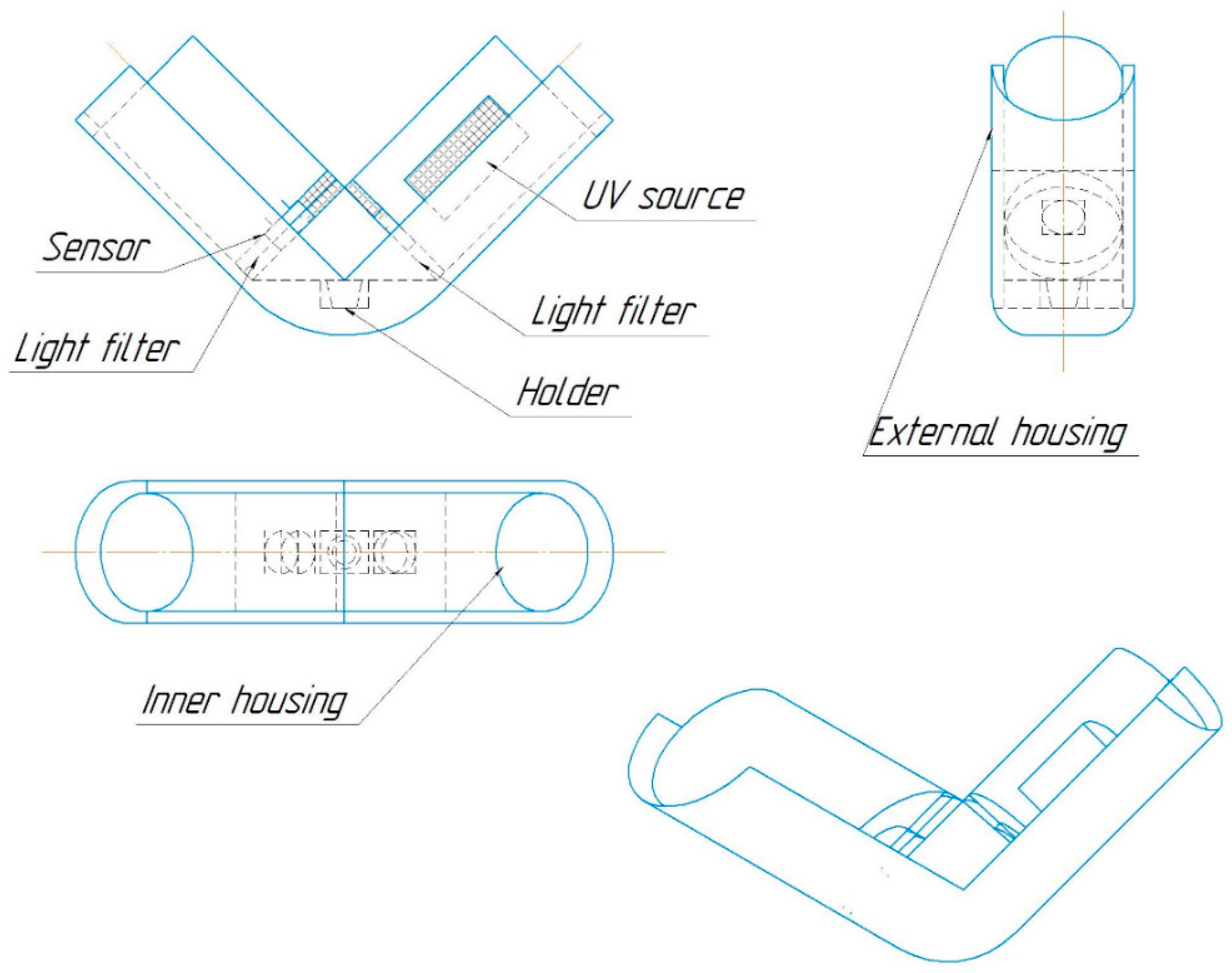
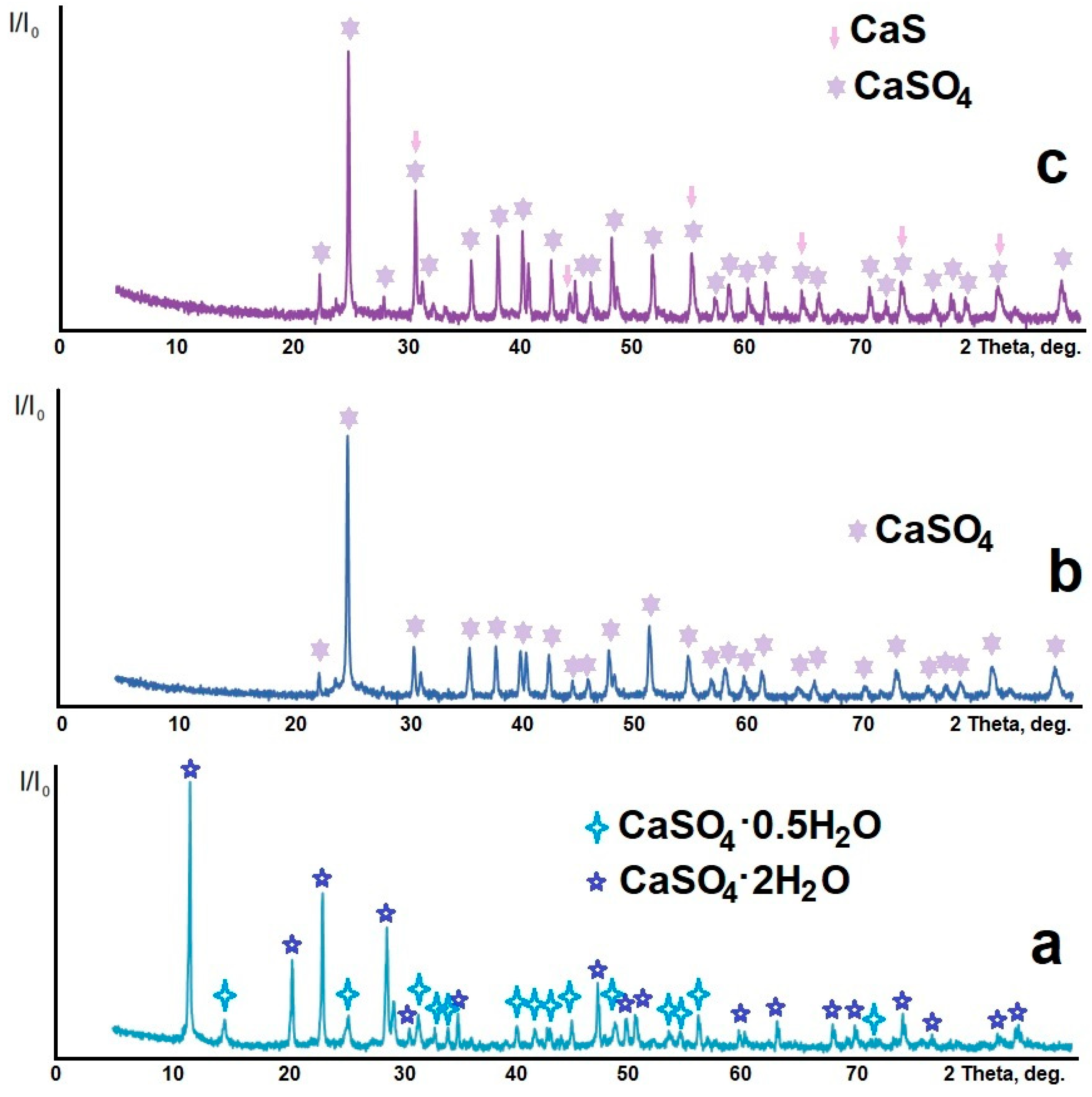
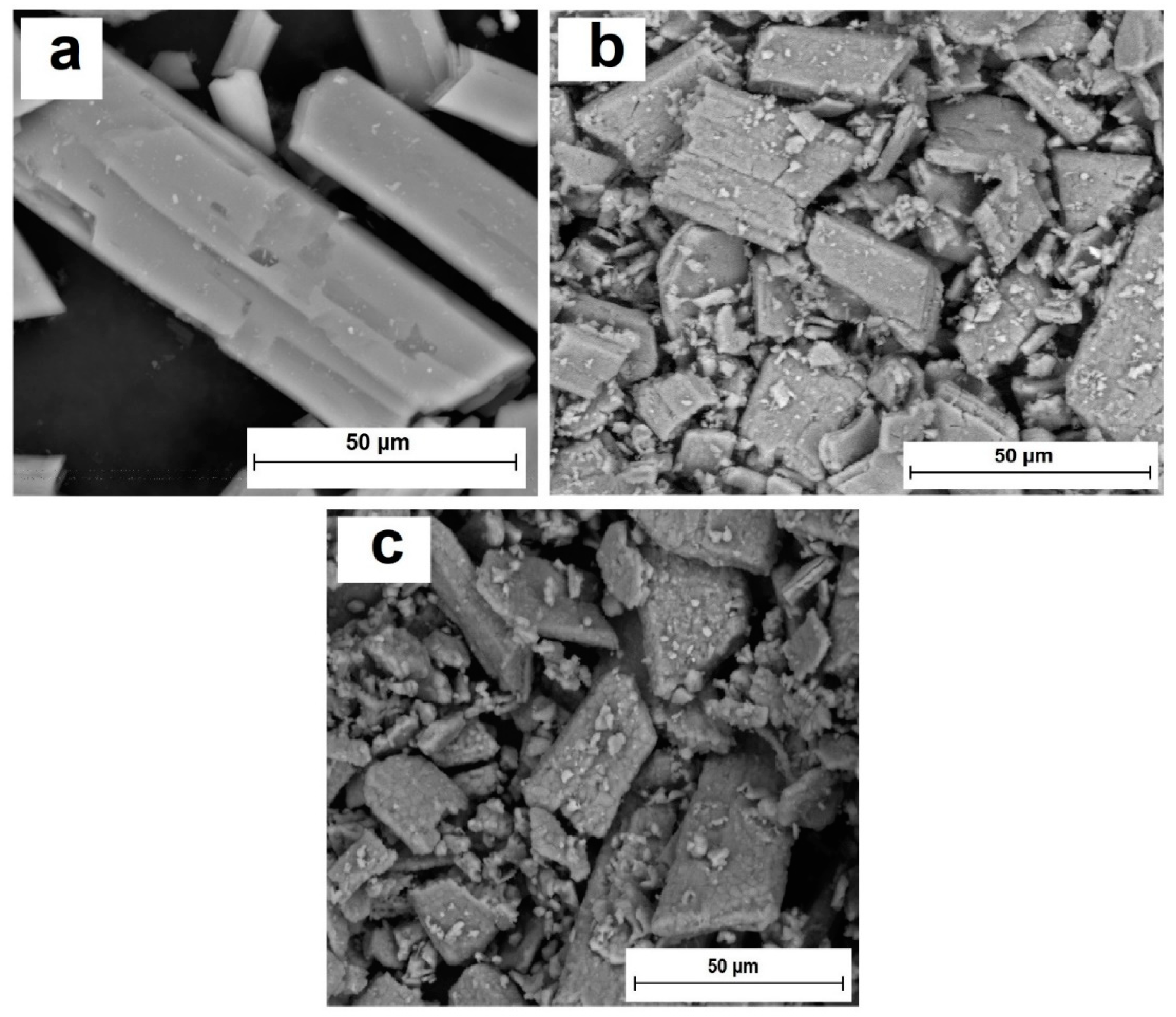
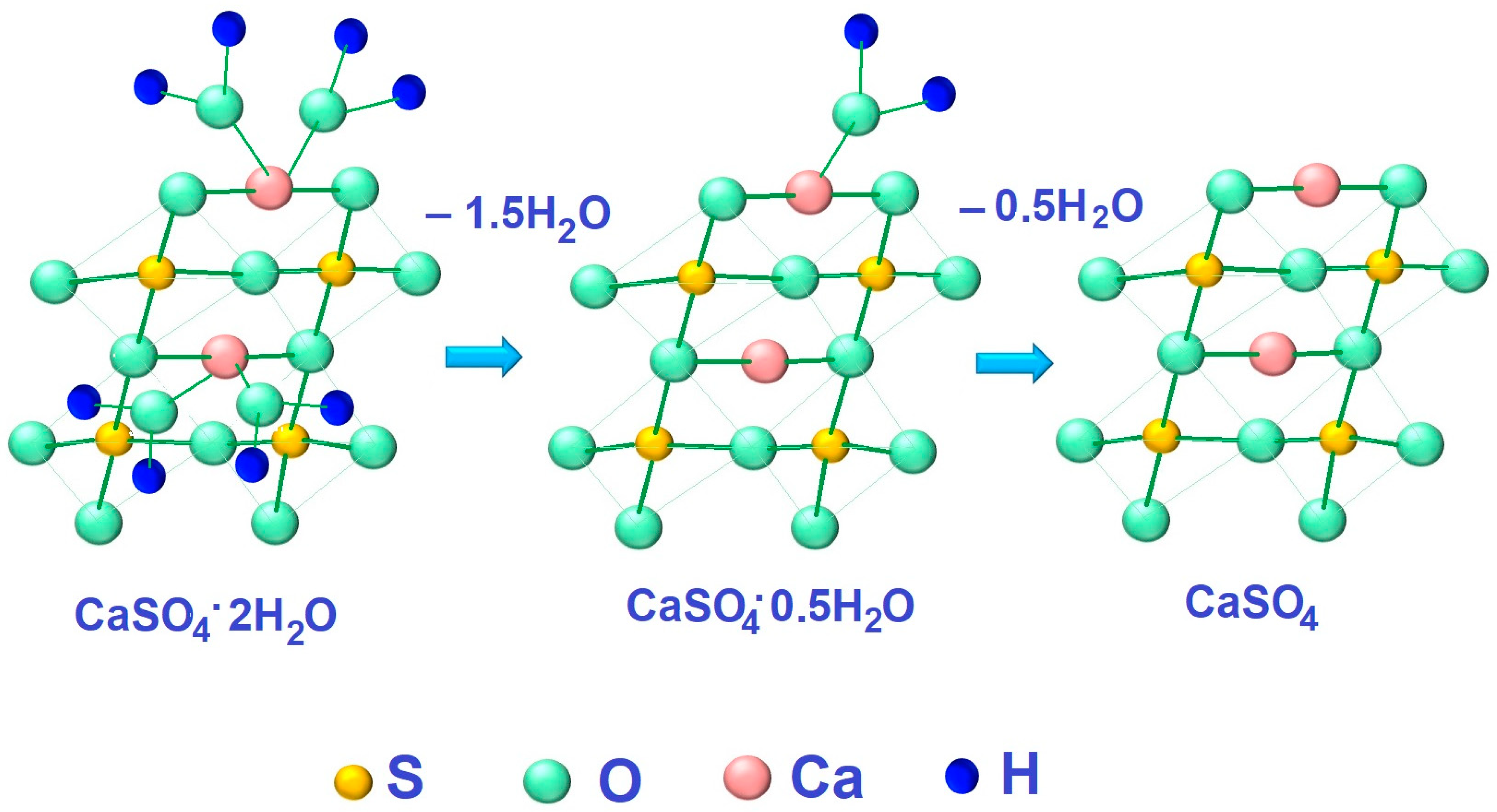
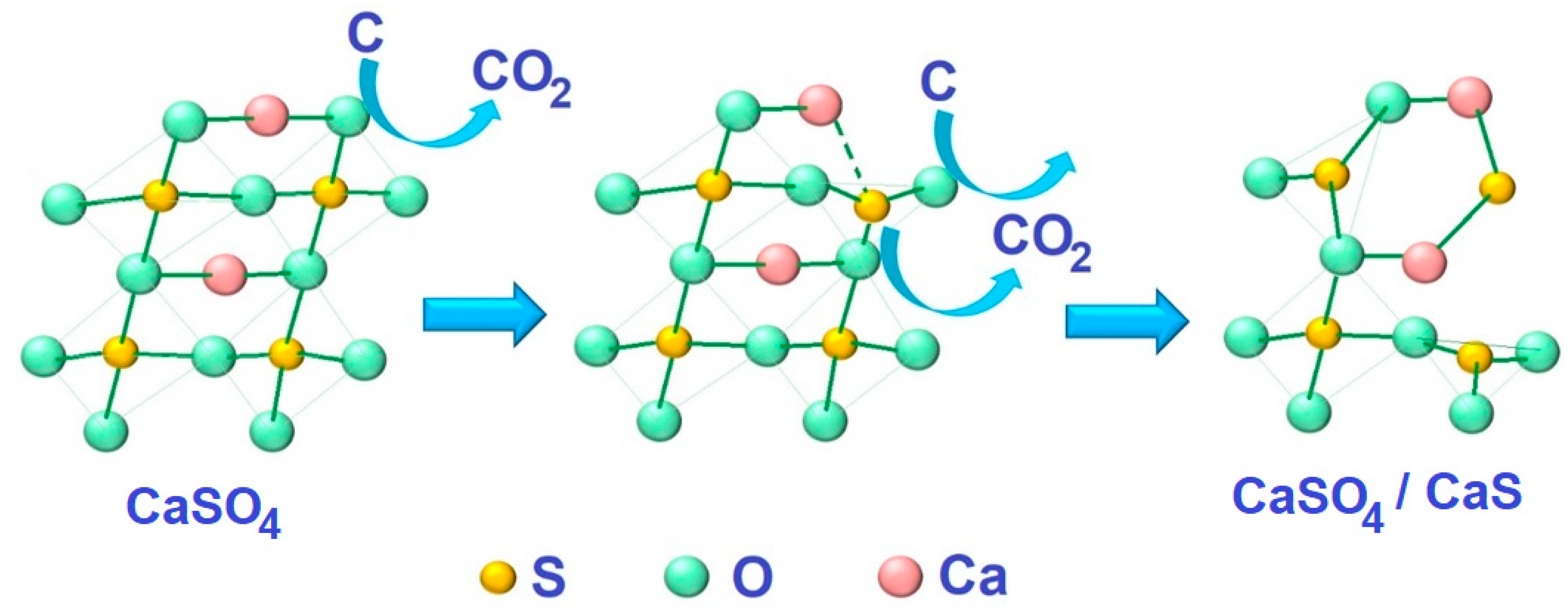

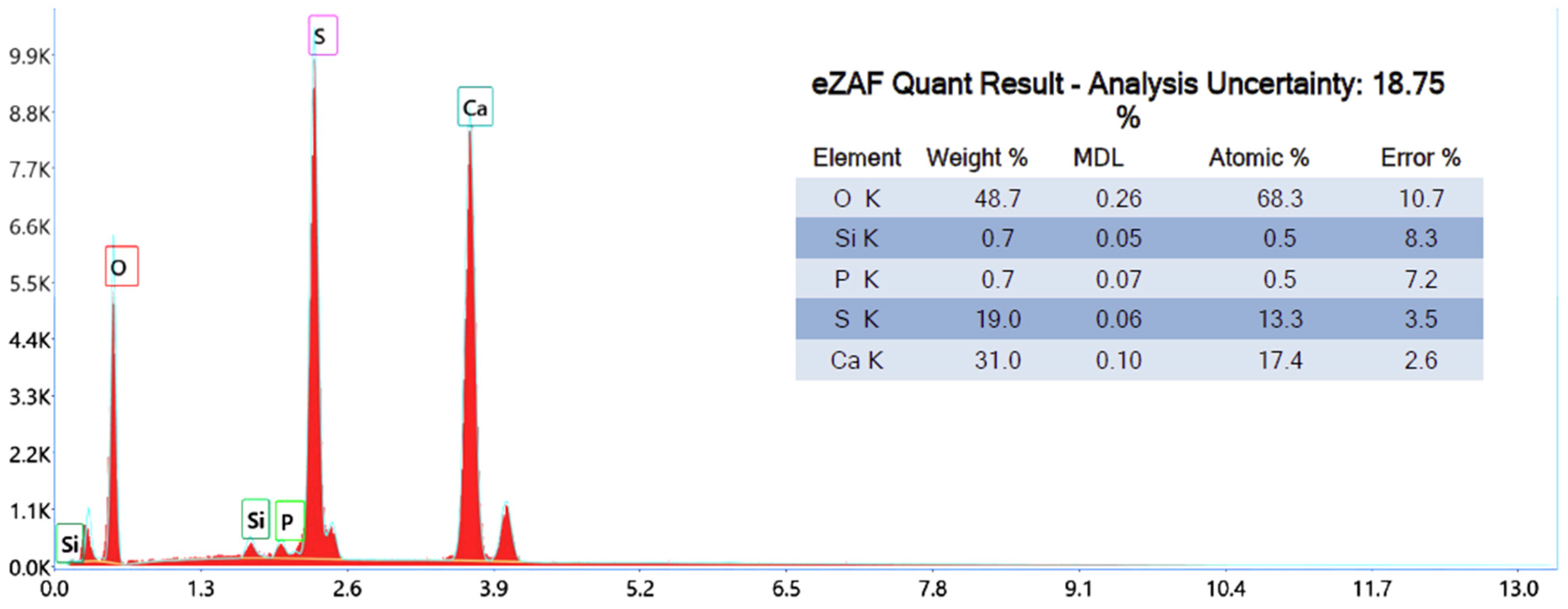
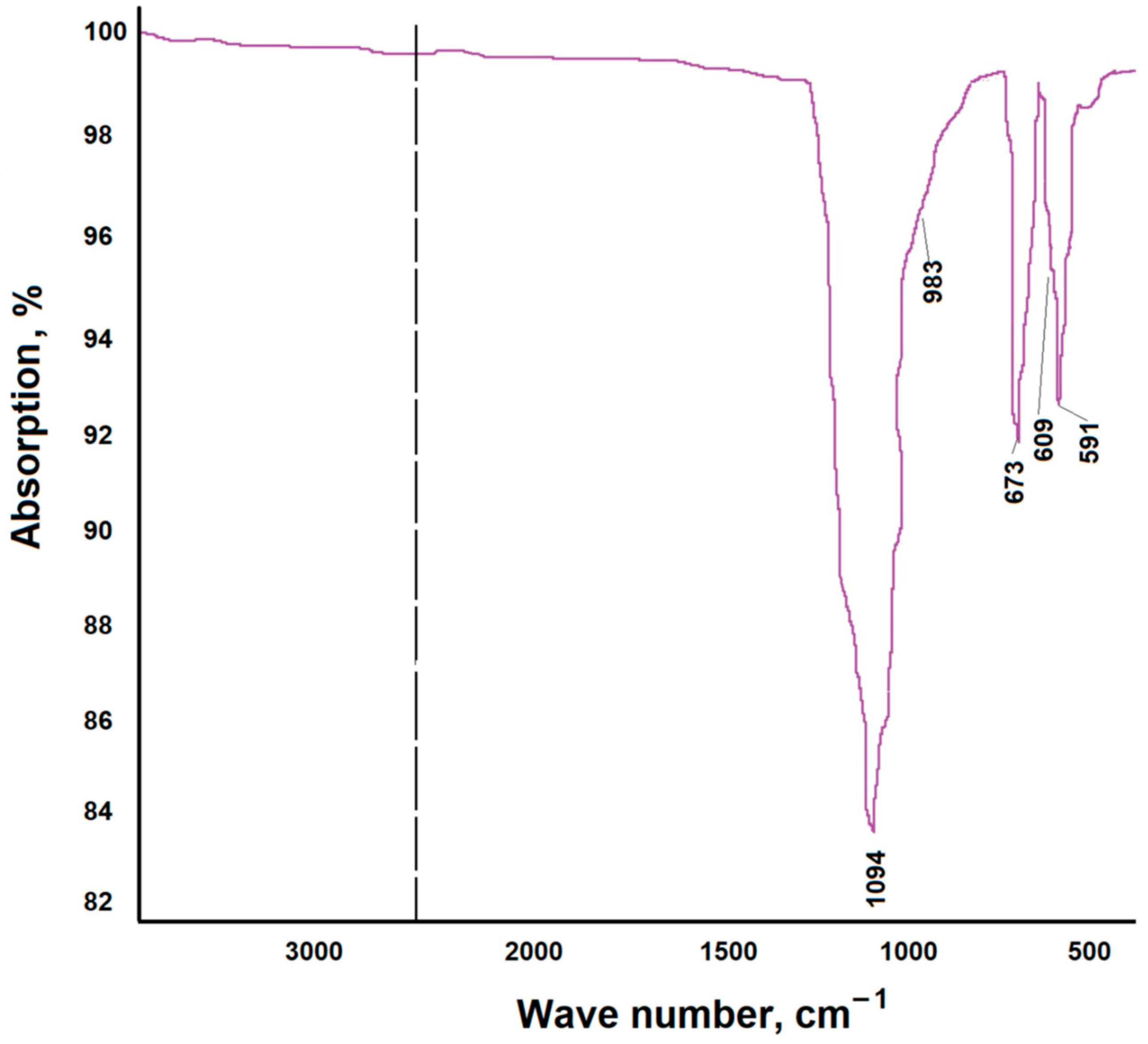
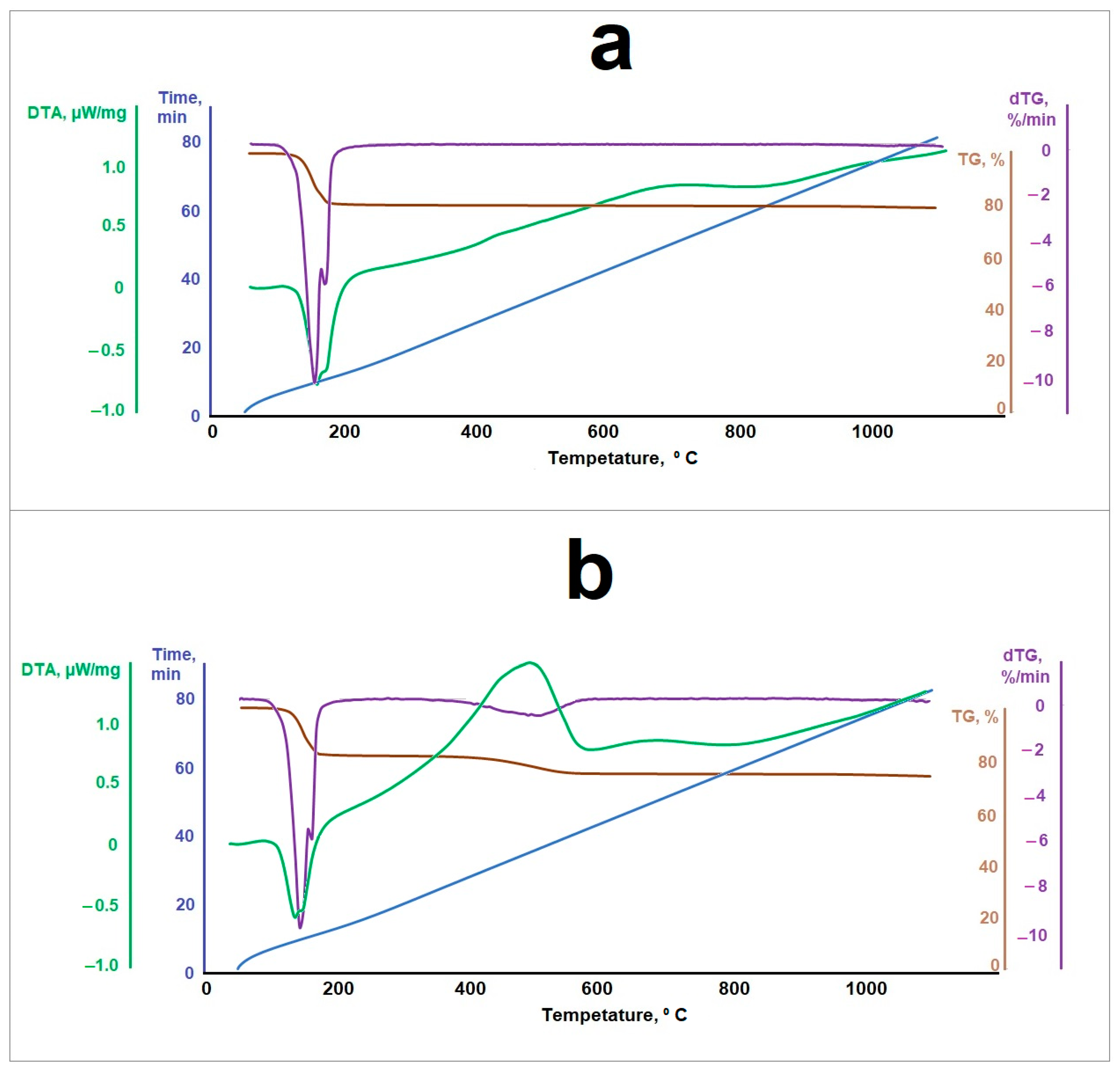
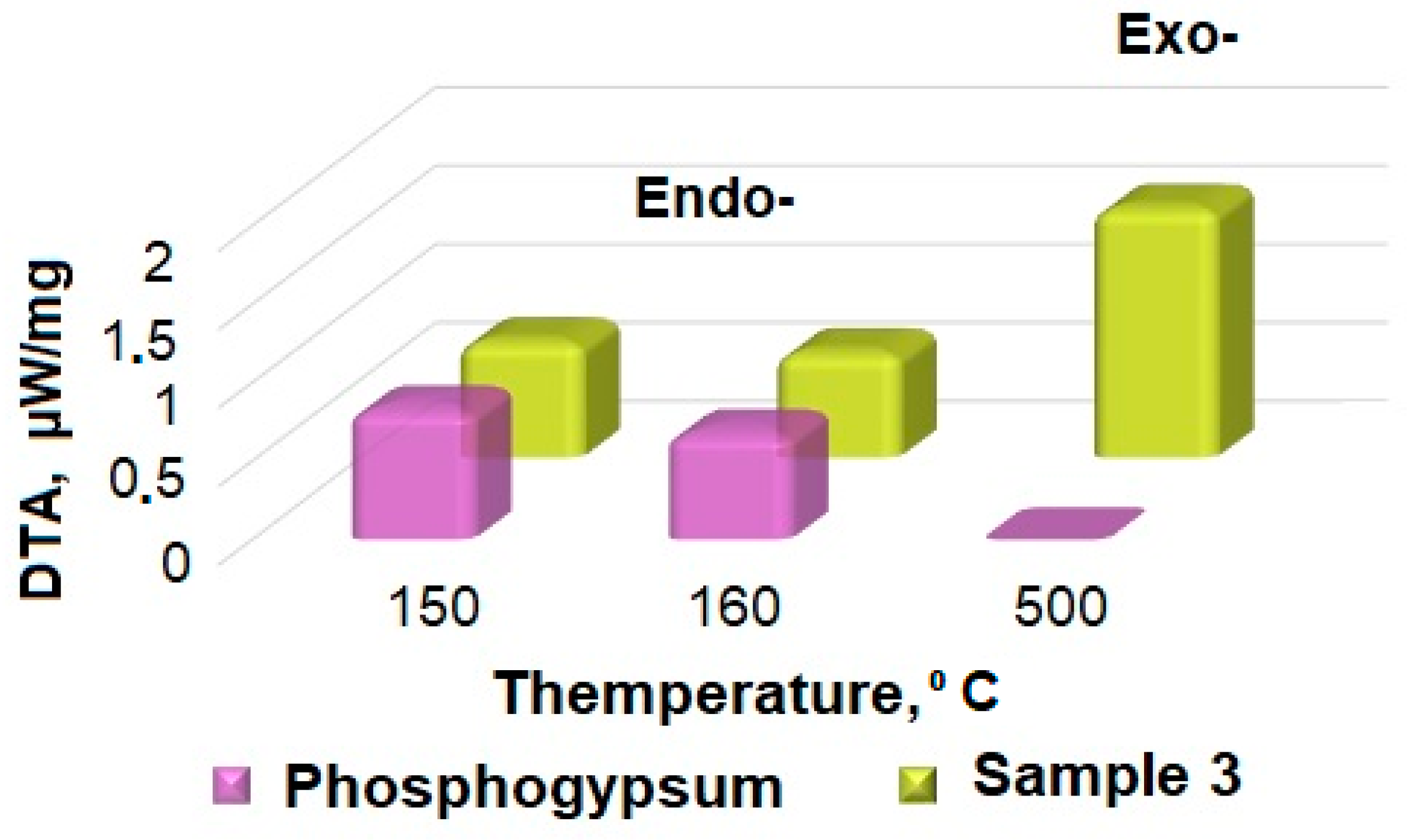
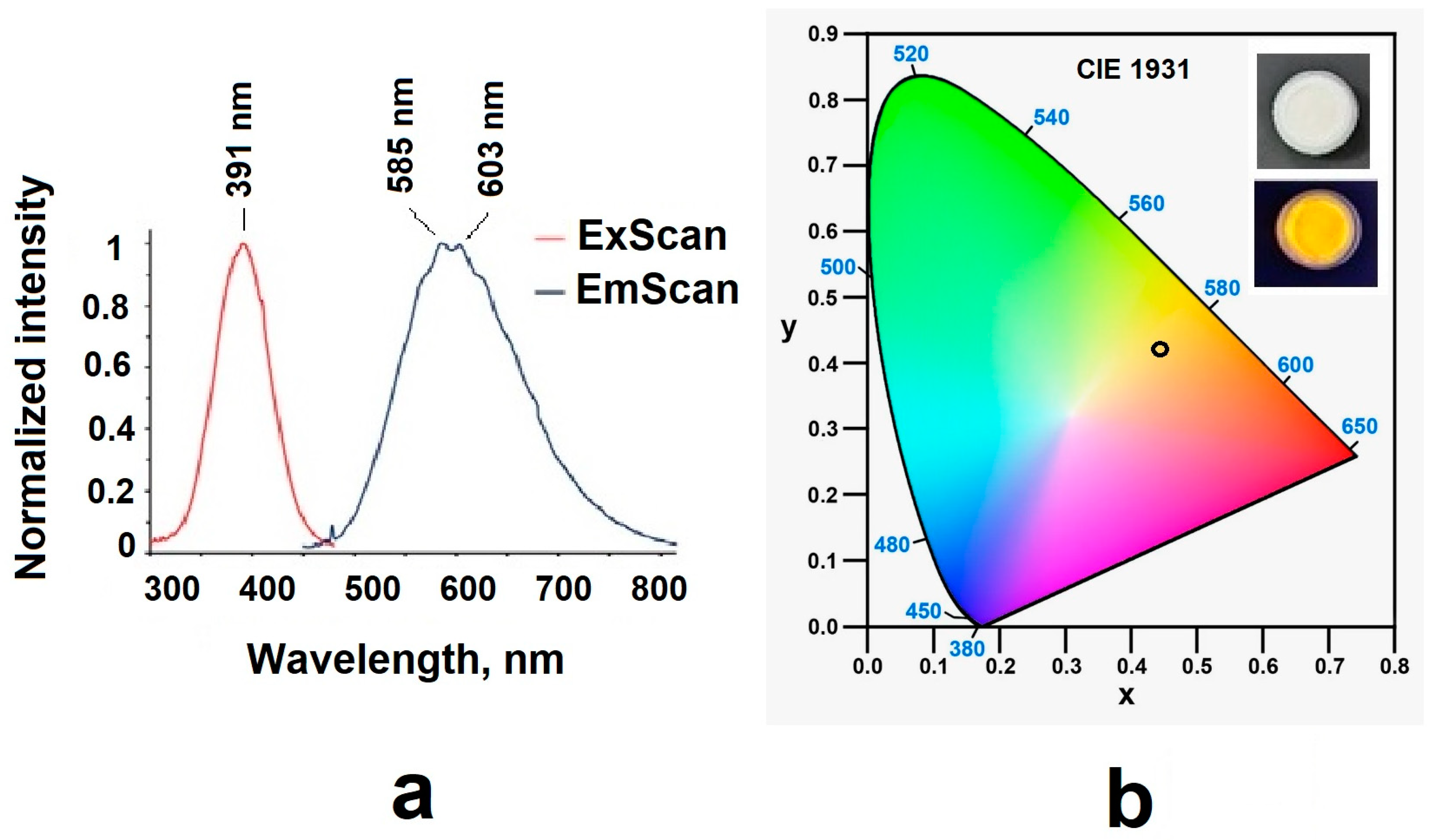
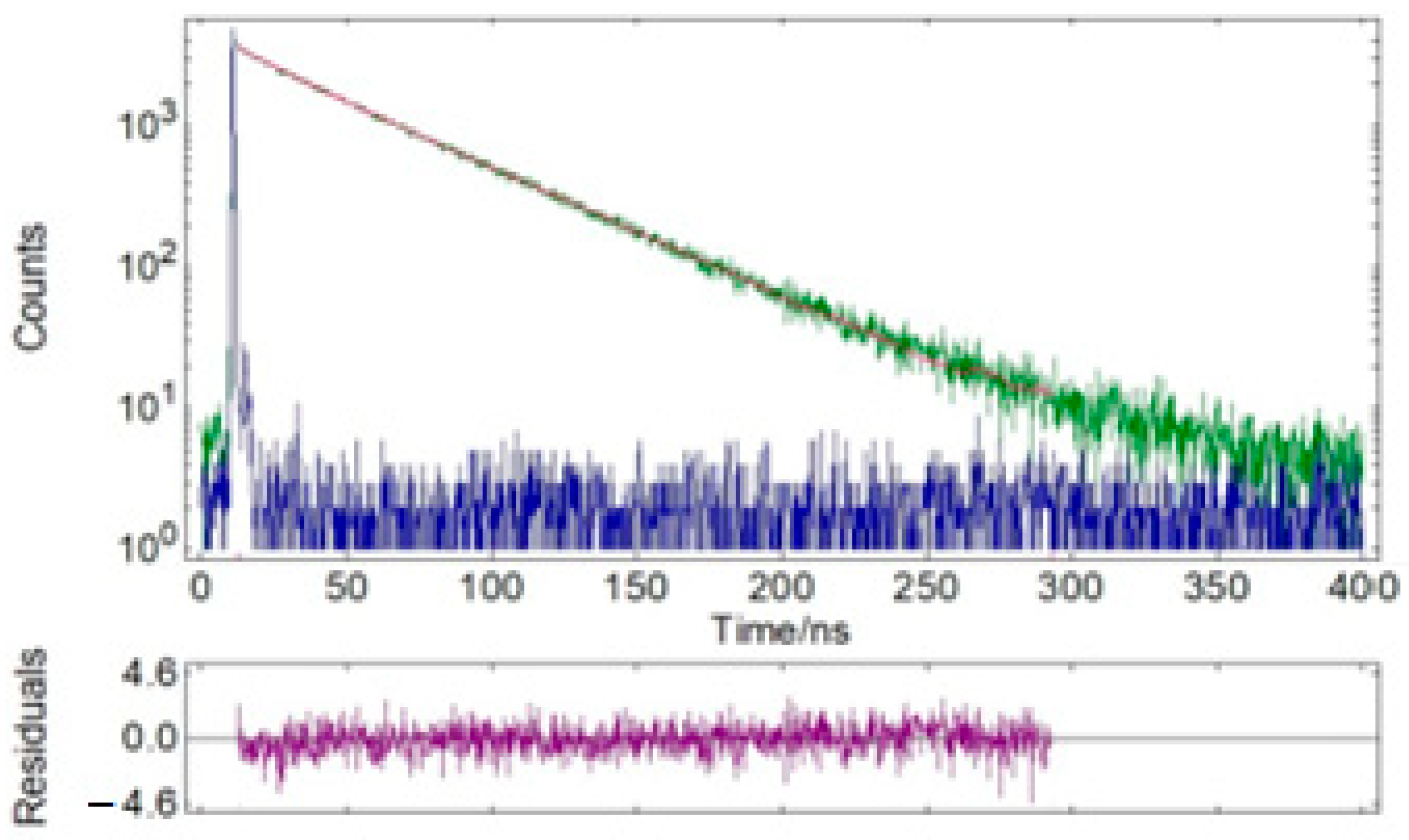

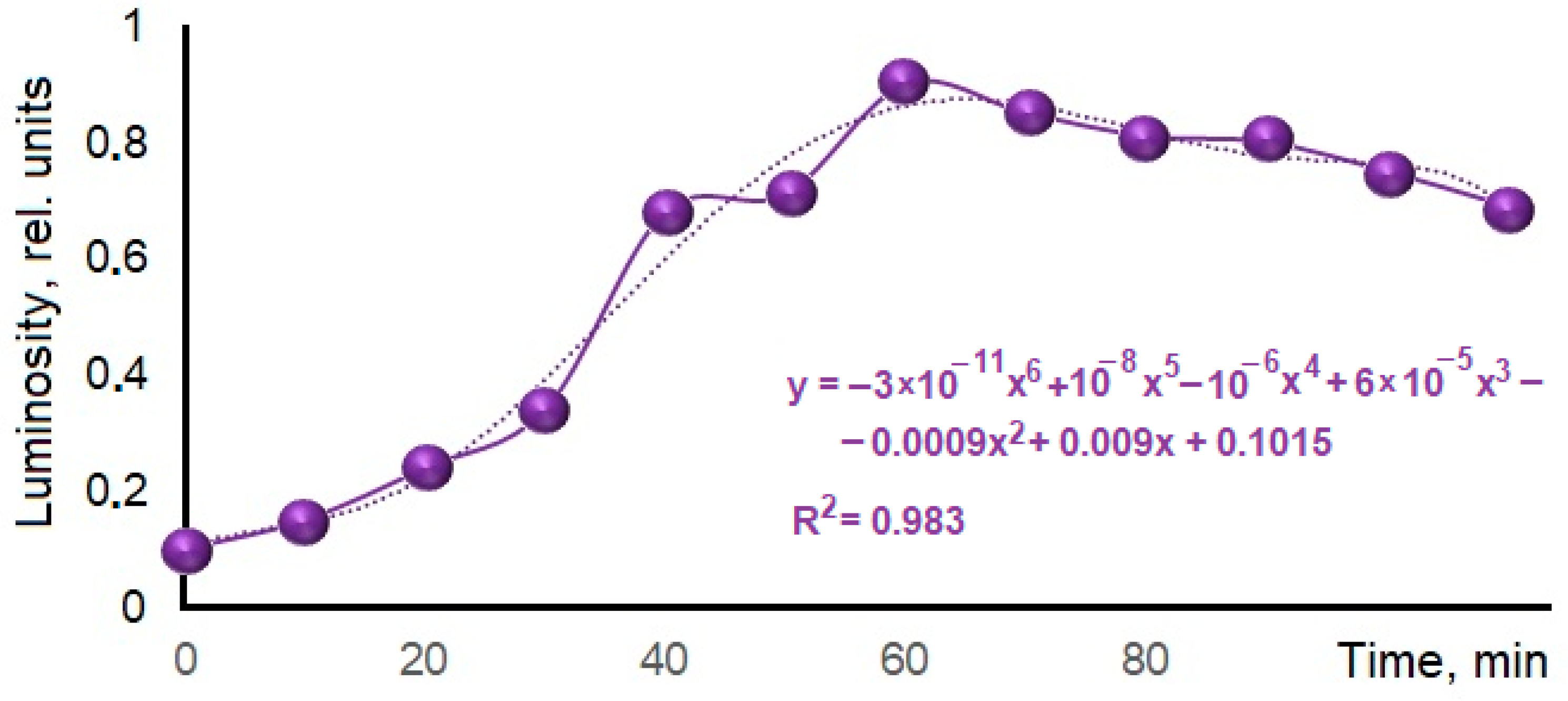
| Sample | Phase | Grid Parameters, nm | β | Volume, nm3 | D, nm | ||
|---|---|---|---|---|---|---|---|
| a | b | c | V | ||||
| Sample 1 | CaSO4·2H2O | 5.67 | 15.11 | 6.49 | 118.5 | 489 | 535 |
| CaSO4·0.5H2O | 12.02 | 6.93 | 12.67 | 90.2 | 1055 | 285 | |
| Sample 2 | CaSO4 | 6.23 | 6.98 | 6.97 | – | 303 | 47 |
| Sample 3 | CaSO4 | 6.99 | 7.00 | 6.24 | – | 305 | 49 |
| CaS | 5.69 | – | – | – | 184 | 43 | |
| Sample | Character | Phosphogypsum | Sample 3 | ||
|---|---|---|---|---|---|
| Temperature, K | Value, µW/mg | Temperature, K | Value, µW/mg | ||
| Peak 1 | Endo | 424 | 0.84 | 421 | 0.74 |
| Peak 2 | Endo | 440 | 0.69 | 429 | 0.67 |
| Peak 3 | Exo | - | - | 773 | 1.59 |
| Excitation, λem [nm] | Emission, λem [nm] | τavr, [ns]/χ2 | ΦF |
|---|---|---|---|
| 391 | 585 | 46.02/1.110 | 0.17 |
| 603 | 45.81/1.034 |
| Solid | ||||||
|---|---|---|---|---|---|---|
| λem [nm] | τ1, [ns] | f1, % | τ2 [ns] | f2, % | τavg, [ns] | χ2 |
| 585 | 16.22 | 5.3 | 47.70 | 94.7 | 46.02 | 1.034 |
| 603 | 15.06 | 5.2 | 47.49 | 94.8 | 45.81 | 1.110 |
| Reducing Agent Fraction, % | Heat Treatment Temperature, К | ||
|---|---|---|---|
| 1073 | 1173 | 1273 | |
| 6.3 | 0.00 | 0.07 | 0.07 |
| 12.6 | 0.00 | 0.64 | 0.07 |
| 18.9 | 0.14 | 1.00 | 0.14 |
| 25.2 | 0.29 | 0.07 | 0.29 |
| 37.8 | 0.50 | 0.21 | 0.50 |
| 50.4 | 0.86 | 0.43 | 0.93 |
| 63.0 | 1.21 | 0.71 | 3.14 |
| 75.6 | 1.29 | 0.14 | 2.29 |
| Reducing Agent Mass, g | Reducing Agent Mole Fraction, % | Relative Luminous Flux (Rel. Units) at Treatment Temperature | ||
|---|---|---|---|---|
| 1073 К | 1173 К | 1273 К | ||
| 1.10 | 6.40 | 0.24 | 0.10 | 0.10 |
| 2.10 | 12.21 | 0.39 | 0.12 | 0.10 |
| 4.30 | 25.00 | 0.86 | 0.35 | 0.15 |
| 6.40 | 37.21 | 0.93 | 0.75 | 0.15 |
| 8.50 | 49.42 | 0.91 | 0.90 | 0.15 |
| 10.70 | 62.21 | 0.90 | 0.88 | 0.10 |
| 12.80 | 74.42 | 0.84 | 0.80 | 0.26 |
| 17.10 | 99.42 | 0.63 | 0.60 | 0.21 |
| Reducing Agent Mass, g | Reducing Agent Mole Fraction, % | Relative Luminous Flux (Rel. Units) | ||
|---|---|---|---|---|
| 973 К, 90 min | 1073 К, 60 min | 1173 К, 30 min | ||
| 4.30 | 50.59 | 0.38 | 0.86 | 0.10 |
| 6.40 | 75.29 | 0.41 | 0.93 | 0.15 |
| 8.50 | 100.00 | 0.51 | 0.91 | 0.72 |
| 10.70 | 125.88 | 0.46 | 0.90 | 0.90 |
| 12.80 | 150.59 | 0.44 | 0.84 | 0.87 |
| 17.10 | 201.18 | 0.41 | 0.63 | 0.74 |
Disclaimer/Publisher’s Note: The statements, opinions and data contained in all publications are solely those of the individual author(s) and contributor(s) and not of MDPI and/or the editor(s). MDPI and/or the editor(s) disclaim responsibility for any injury to people or property resulting from any ideas, methods, instructions or products referred to in the content. |
© 2024 by the authors. Licensee MDPI, Basel, Switzerland. This article is an open access article distributed under the terms and conditions of the Creative Commons Attribution (CC BY) license (https://creativecommons.org/licenses/by/4.0/).
Share and Cite
Medennikov, O.A.; Egorova, M.A.; Shabelskaya, N.P.; Rajabov, A.; Sulima, S.I.; Sulima, E.V.; Khliyan, Z.D.; Monastyrskiy, D.I. Studying the Process of Phosphogypsum Recycling into a Calcium Sulphide-Based Luminophor. Nanomaterials 2024, 14, 904. https://doi.org/10.3390/nano14110904
Medennikov OA, Egorova MA, Shabelskaya NP, Rajabov A, Sulima SI, Sulima EV, Khliyan ZD, Monastyrskiy DI. Studying the Process of Phosphogypsum Recycling into a Calcium Sulphide-Based Luminophor. Nanomaterials. 2024; 14(11):904. https://doi.org/10.3390/nano14110904
Chicago/Turabian StyleMedennikov, Oleg A., Marina A. Egorova, Nina P. Shabelskaya, Asatullo Rajabov, Sergey I. Sulima, Elena V. Sulima, Zlatislava D. Khliyan, and Daniil I. Monastyrskiy. 2024. "Studying the Process of Phosphogypsum Recycling into a Calcium Sulphide-Based Luminophor" Nanomaterials 14, no. 11: 904. https://doi.org/10.3390/nano14110904
APA StyleMedennikov, O. A., Egorova, M. A., Shabelskaya, N. P., Rajabov, A., Sulima, S. I., Sulima, E. V., Khliyan, Z. D., & Monastyrskiy, D. I. (2024). Studying the Process of Phosphogypsum Recycling into a Calcium Sulphide-Based Luminophor. Nanomaterials, 14(11), 904. https://doi.org/10.3390/nano14110904






